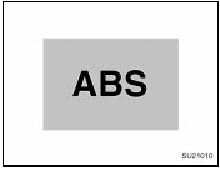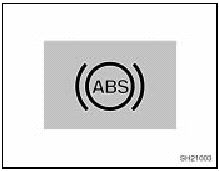 Toyota Yaris: Brake system
Toyota Yaris: Brake system
The tandem master cylinder brake system is a hydraulic system with two separate sub-systems. If either sub-system should fail, the other will still work. However, the pedal will be harder to press, and your stopping distance will increase. Also, the brake system warning light may come on.
CAUTION.
Do not drive your vehicle with only a single brake system. Have your brakes fixed immediately.
BRAKE BOOSTER
The brake booster uses engine vacuum to power-assist the brakes. If the engine should quit while you are driving, you can bring the vehicle to a stop with normal pedal pressure. There is enough reserved vacuum for one or two stops—but no more!
CAUTION.
Do not pump the brake pedal if the engine stalls. Each push on the pedal uses up your reserved vacuum.
Even if the power assist is completely lost, the brakes will still work. But you will have to push the pedal hard, much harder than normal.
And your braking distance will increase.
ANTI-LOCK BRAKE SYSTEM (with “ABS” warning light)
The anti-lock brake system is designed to help prevent lock-up of the wheels during a sudden braking or braking on slippery road surfaces. This assists in providing directional stability and steering performance of the vehicle under these circumstances.
Effective way to press the ABS brake pedal: When the anti-lock brake system function is in action, you may feel the brake pedal pulsating and hear a noise. In this situation, to let the anti-lock brake system work for you, just hold the brake pedal down more firmly. Do not pump the brake in a panic stop. This will result in reduced braking performance.
The anti-lock brake system becomes operative after the vehicle has accelerated to a speed in excess of approximately 10 km/h (6 mph). It stops operating when the vehicle decelerates to a speed below approximately 5 km/h (3 mph).
Depressing the brake pedal on slippery road surfaces such as on a manhole cover, a steel plate at a construction site, joints in a bridge, etc. on a rainy day tends to activate the anti-lock brake system.
You may hear a click or motor sound in the engine compartment for a few seconds when the engine is started or just after the vehicle begins to move. This means that the anti-lock brake system is in the self-check mode, and does not indicate a malfunction.
When the anti-lock brake system is activated, the following conditions may occur. They do not indicate a malfunction of the system:
- You may hear the anti-lock brake system operating and feel the brake pedal pulsating and the vibrations of the vehicle body and steering wheel. You may also hear the motor sound in the engine compartment even after the vehicle is stopped.
-
At the end of the anti-lock brake system activation, the brake pedal may move a little forward.
CAUTION.
Do not overestimate the anti-lock brake system: Although the anti-lock brake system assists in providing vehicle control, it is still important to drive with all due care and maintain a moderate speed and safe distance from the vehicle in front of you, because there are limits to the vehicle stability and effectiveness of steering wheel operation even with the anti- lock brake system on.
If tire grip performance exceeds its capability, or if hydroplaning occurs during high speed driving in the rain, the anti-lock brake system does not provide vehicle control.
Anti-lock brake system is not designed to shorten the stopping distance: Always drive at a moderate speed and maintain a safe distance from the vehicle in front of you.
Compared with vehicles without an anti-lock brake system, your vehicle may require a longer stopping distance in the following cases: Driving on rough, gravel or snow- covered roads.
Driving with tire chains installed.
Driving over the steps such as the joints on the road.
Driving on roads where the road surface is pitted or has other differences in surface height.
Install all 4 tire of specified size at appropriate pressure: The anti-lock brake system detects vehicle speeds using the speed sensors for respective wheels’ turning speeds. The use of tires other than specified may fail to detect the accurate turning speed resulting in a longer stopping distance.

Type A

Type B
“ABS” warning light
This light comes on when the ignition key is turned to the “ON” position. If the anti- lock brake system works properly, the light turns off after a few seconds. Thereafter, if the system malfunctions, the light comes on again.
When the “ABS” warning light is on (and the brake system warning light is off), the anti-lock brake system does not operate, but the brake system still operates conventionally.
When the “ABS” warning light is on (and the brake system warning light is off), the anti-lock brake system does not operate so that the wheels could lock up during a sudden braking or braking on slippery road surfaces.
If either of the following conditions occurs, this indicates a malfunction somewhere in the components monitored by the warning light system. Contact your Toyota dealer as soon as possible to service the vehicle.
- The light does not come on when the ignition key is turned to the “ON” position, or remains on.
- The light comes on while you are driving.
A warning light turning on briefly during operation does not indicate a problem.
CAUTION.
If the “ABS” warning light remains on together with the brake system warning light, immediately stop your vehicle at a safe place and contact your Toyota dealer.
In this case, not only the anti-lock brake system will fail but also the vehicle will become extremely unstable during braking.
 Iridium-tipped spark plugs
Iridium-tipped spark plugs
Your engine is fitted with iridium-tipped spark plugs.
NOTICE.
Use only iridium-tipped spark plugs.
Do not adjust gaps for engine performance or smooth driveability.
...
 Electric power steering system
Electric power steering system
The electric power steering system, using an electric motor, assists the turning
of the steering wheel.
In the following cases, you may feel the steering becomes heavy. But it is not
a malfunctio ...
See also:
Hood
To open the hood:
1. Pull the hood lock release lever. The hood will spring up slightly.
CAUTION.
Before driving, be sure that the hood is closed and securely locked. Otherwise,
the hood ma ...
How to start the engine
—Cranking hold function
Once you turn the ignition key to “START” position and release it, the cranking
hold function continues to crank the engine in “ON” position until it starts.
Th ...
Safety symbol
When you see the safety symbol shown above, it means: “Do not...”; “Do not
do this”; or “Do not let this happen”.
...
